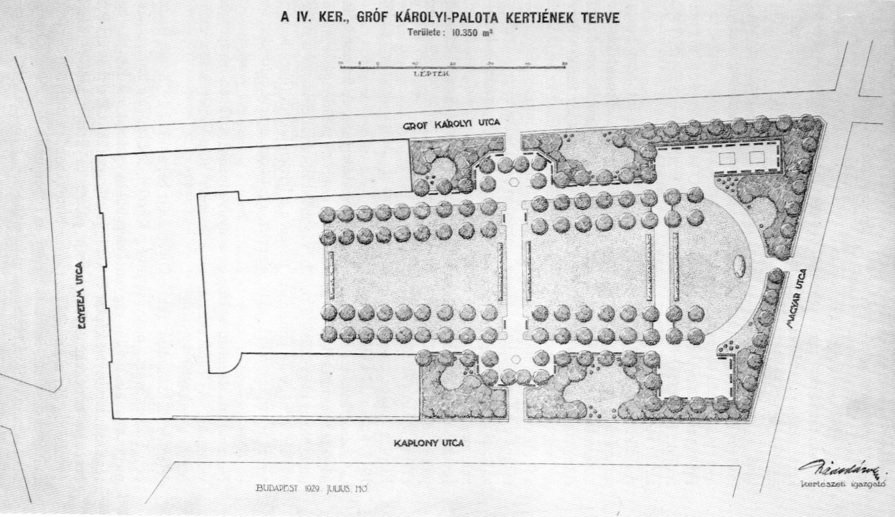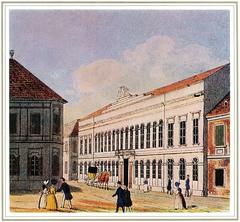
Károlyi Palace Budapest: Visiting Hours, Tickets, and Travel Guide
Date: 14/06/2025
Introduction: A Journey Through History and Culture
Károlyi Palace, located in Budapest’s vibrant Palotanegyed (Palace District), stands as a monumental testament to Hungary’s aristocratic heritage, architectural mastery, and enduring cultural significance. Once a noble residence and social hub for the illustrious Károlyi family, today the palace is home to the Petőfi Literary Museum and a beloved urban green space—Károlyi Garden. Visitors can expect a seamless blend of historic grandeur, literary treasures, and tranquil gardens, making it an essential stop for those exploring Budapest’s historical sites.
This detailed guide provides everything you need to know about Károlyi Palace: from its layered history and stunning architecture to practical visiting details, ticketing, accessibility, nearby attractions, and insider tips for making the most of your visit.
For more about the palace’s history and visitor information, consult the Petőfi Literary Museum website, reformatus.hu, Wikipedia’s Károlyi Palace page, and Lonely Planet’s guide.
Table of Contents
- Historical Overview
- Visiting Information
- Károlyi Garden
- Petőfi Literary Museum: Collections and Events
- Nearby Attractions
- Frequently Asked Questions (FAQ)
- Final Tips for Visitors
- Sources
Historical Overview
Origins and Architectural Evolution
The Károlyi Palace’s story began in the late 17th century, with a significant transformation occurring after Count Antal Károlyi acquired the property in 1768. His 1791 renovation laid the foundation for the palace’s evolving grandeur. In 1832, Count György Károlyi commissioned renowned architect Anton Pius Riegel to redesign the palace in the neo-classical style, with further input from Heinrich Koch and Mihály Pollack. Later, architect Miklós Ybl added romantic and historicist touches, including a greenhouse and possibly the chapel’s decorative design (Wikipedia: Károlyi Palace, Budapest (Károlyi Street)).
Not only did the palace serve as a residence, but it also became a center for cultural and social gatherings, hosting Hungary’s first large-scale applied arts exhibition in 1880 (PestBuda). Archaeological excavations have revealed even deeper layers of history, including remnants of an ancient Turkish house and medieval cemetery under the palace grounds.
Cultural Significance
Throughout its history, Károlyi Palace has been a focal point for Budapest’s intellectual and social elite. Frequented by literary figures like Mihály Vörösmarty and Ferenc Kölcsey, the palace contributed to the city’s vibrant literary and artistic scene (We Love Budapest). In the turbulent 20th century, the building transitioned from private residence to public institution, becoming the home of the Petőfi Literary Museum in 1954 (Google Arts & Culture).
Visiting Information
Visiting Hours
-
Károlyi Palace & Petőfi Literary Museum:
Tuesday to Sunday: 10:00 AM – 6:00 PM (last entry 30 minutes before closing)
Monday: Closed
(Check the official website for seasonal changes or special closures.) -
Károlyi Garden:
Open daily from early morning until dusk.
Tickets and Booking
- Museum Admission: 1,000–2,000 HUF for adults; discounts for students, seniors, and families.
- Garden Entry: Free.
- Purchase: Buy tickets onsite or online via the museum’s website. Advance booking is advised during peak seasons.
Accessibility
The palace and museum are wheelchair accessible, with ramps, elevators, and accessible restrooms. The garden features flat, stroller-friendly paths.
Guided Tours and Travel Tips
Guided tours are regularly available in Hungarian and English and can be booked in advance. Tours provide rich historical and literary context and often include access to otherwise restricted areas.
Getting There
- By Metro: M3 (Kálvin tér station), short walk to Károlyi utca.
- By Tram: Lines 47 and 49 stop at Kálvin tér.
- By Bus: Numerous lines serve the Palace District.
Nearby Landmarks:
Hungarian National Museum, Great Synagogue, University Church, Váci utca shopping street, and the Central Market Hall are all within walking distance.
Károlyi Garden: A Historic Urban Oasis
Originally a private garden for the Károlyi family, Károlyi Garden is now Budapest’s oldest public park (budappest.com). Landscaped in the French formal style and later adapted as an English garden, it features manicured paths, mature trees, playgrounds, statues, and seasonal floral displays. The garden is a favorite for families, readers, and anyone seeking a peaceful retreat in the city.
Petőfi Literary Museum: Collections and Events
The Petőfi Literary Museum, housed within the palace since 1954, is a premier repository of Hungarian literary heritage. Its extensive collections include manuscripts, books, personal relics, and artifacts connected to Sándor Petőfi and many other writers (Lonely Planet). Permanent and temporary exhibitions highlight Hungarian literature’s development from the 18th to the 21st century. The museum also hosts frequent readings, concerts, workshops, and summer theater events in the garden (PIM official site).
Audio guides in multiple languages and guided tours are available. The museum shop offers literary-themed gifts, and a terrace café provides refreshments in a historic setting.
Frequently Asked Questions (FAQ)
What are the Károlyi Palace visiting hours?
Tuesday to Sunday, 10:00 AM to 6:00 PM; closed Mondays. Garden open daily. Check official site for updates.
How much are tickets to Károlyi Palace?
Adults: 1,000–2,000 HUF; discounts for students, seniors, and families. Garden entry is free.
Are guided tours available?
Yes, in Hungarian and English. Booking in advance is recommended.
Is the palace wheelchair accessible?
Yes, with ramps, elevators, and accessible restrooms.
Can I visit Károlyi Garden without entering the museum?
Yes, the garden is a public park and free to enter.
Final Tips for Visitors
- Visit during daylight to appreciate the palace’s exterior and the garden’s beauty.
- Book tickets and tours in advance during high season.
- Combine your visit with nearby attractions such as the National Museum or a stroll along the Danube.
- Check the museum’s calendar for special exhibitions, concerts, or family events.
- Respect photography rules: Non-flash photography is usually permitted, but check for restrictions.
Sources
- reformatus.hu
- Wikipedia: Károlyi Palace, Budapest (Károlyi Street)
- We Love Budapest
- budappest.com
- PestBuda
- Petőfi Literary Museum official site
- Lonely Planet Budapest Guides








































































































































































